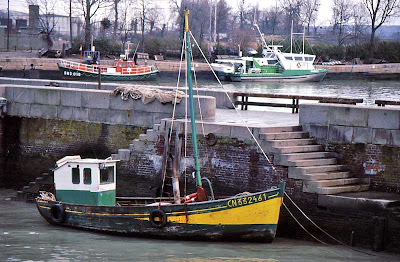I just couldn't resist getting out another tray of slides and looking at the pictures. So, naturally, I decided I should start scanning them. That means I'll be posting some of them here.
In January 1992, I had just finished my graduate work at Berkeley. At the time I was working as a research assistant on a project related to suburb-to-suburb commuting. My professor, an Englishman well known in the transportation field, decided that we should go to Paris and interview some of the transportation planners there about their solutions to the problem. How could I say no ?
 The Cathedral of Saints Peter and Paul in Nantes.
The Cathedral of Saints Peter and Paul in Nantes.Off we went, in early January. Brrrrr. We were able to cope with the cold ; something about being in Paris makes everything ok. We had good meetings, including one little side trip to Nantes to talk to some planners there. That meeting was at the top of a high-rise building, and I was able to take some photos of Nantes from up there. These are a few of them.
 A view of Nantes from a tall office building.
A view of Nantes from a tall office building.Nantes is the sixth largest city in France, home to over 280,000
Nantais, and over 700,000 in the metro area. It's location on the Loire river estuary makes it a seaport with a healthy industrial economy. Nantes is the capital of Brittany, and boasts a 15th century castle built by the famed
Ducs de Bretagne. It is also the place where King Henry IV signed
l'édit de Nantes (the Edict of Nantes) that granted protestants civil rights in French society and laid the foundation for secularism in France - of course, it was revoked by Louis XIV in the 17th century, but I digress. I didn't spend much time in Nantes and don't really know the place at all. But my overall impression was very positive.
 Another church in Nantes. Which one ?
Another church in Nantes. Which one ?Needless to say, I had to practically
beg Ken to come on this trip with me. Not. After the meetings were over, he and I rented a car and drove out to Normandy and up to the coast. We made our way along the Norman coast to Brittany and continued around the coast down to the island of Noirmoutier, then made our way up the Loire Valley and back to Paris.
I'll start posting some of the photos from that trip tomorrow.
 The town and port of Carteret, when the tide is in. When the tide is out, there's almost no water in the port, just mud.
The town and port of Carteret, when the tide is in. When the tide is out, there's almost no water in the port, just mud.


























































